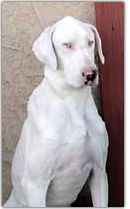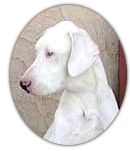|

– Blue
Eyes, Stormy Skies –
February
18, 2002 – As you can see, I am working on a new design for
Ginnie.com and DaDane of DaWeek. This is a test run. Hopefully my
site will be easier to navigate with the new layout and more user-friendly
drop-down menus. Things may be a little "catawampus" for
awhile until I reconfigure all the pages to match, so please be
patient.

Last Week's DaDane
Well, well, well... it seems last week's
DaDane created a bit of a ruckus in some circles. Fanny's pretty
blue eyes led some people to assume she was deaf, blind, or both.
Let me assure you, Fanny has perfect hearing and perfect eyesight.
Blue eyes are not inevitably connected to sensory deficiencies and
Fanny's breeder made sure she was not impaired before she was sold.
It's worth noting, too, that any dog with an AKC obedience title,
like Fanny has, must have sight and hearing. The Obedience Regulations
state: "A dog that is blind or deaf....may not compete in any
Obedience Trial....".

There appears to be some confusion about what causes the above-mentioned
deficits, so I decided that should be our focus this week.

Stella
Today's portrait features Stella, who is deaf and visually impaired.
The photos I worked from were taken at the 2000 GDCA National when
Stella was just 8 months old.

Stella lives in northwest Missouri with the Petersen family. She
is the youngest in a household of 12 dogs! Michelle Petersen, Stella's
mom, gives us the roll-call: "Four rescue Danes (which includes
Henry, who is ~6 years old and blind in one eye, partially blind
in the other; he is my most recent foster-adoptee), six retired
Greyhounds, a 10-year-old Siberian Husky and an 11-year-old Retriever/Chow
mix." She goes on to say, "It's getting to be a more 'geriatric
herd' these days, but everyone is doing pretty well. Some days when
Stella, Gretchen (our brindle rescue Dane), and Henry are at the
baby gate looking into the kitchen, I can't help but call them 'deaf,
dumb and blind' – but they know I am just kidding! Stella
is the youngest of the bunch. Our oldest, Moose, is 13 1/2."

 Today
happens to be Stella's second birthday. (Happy birthday, Stella!)
She is very fortunate to have found such a wonderful home, one that's
willing – and able – to adjust to her special
needs. Stella was the product of a harlequin-to-harlequin breeding
by what Michelle calls a backyard breeder in a puppy mill environment.
"From what I can tell, this breeder often has one or two deaf
pups per litter. Stella's breeder actually encouraged me to breed
Stella! Can you imagine? No way!
... All things considered, Stella is doing very well despite her
sensory deficits. She even has a 'boyfriend,' a deaf, large male
Dane (neutered, of course!) who comes to visit us occasionally.
Stella loves to show him around the yard, etc. She is our tallest
dog, but weighs a 'petite' 120. She is still very intelligent and
she has recently learned a few new ASL signs. I am trying to learn
the alphabet myself, so I frequently practice with her. We continue
to see the veterinary eye doctor yearly, and she takes prescription
eye drops, but seems to be in excellent health. I have a copy of
the report by her ophthalmologist which states, 'Stella has very
abnormal eye formation from a condition called Waardenburg's Syndrome.
This inherited condition occurs in white or merle animals and affects
both the ears and eyes of animals with inadequate pigment. Stella
is a classic case as she is deaf and has significant ocular changes.
Her pupils are misshapen and misplaced. Her globes are slightly
micropthalmic (smaller than they should be). The lens in her left
eye is misshapen and subluxated (partially in the wrong spot). Again,
all of these changes are from her genetic abnormality.'" Today
happens to be Stella's second birthday. (Happy birthday, Stella!)
She is very fortunate to have found such a wonderful home, one that's
willing – and able – to adjust to her special
needs. Stella was the product of a harlequin-to-harlequin breeding
by what Michelle calls a backyard breeder in a puppy mill environment.
"From what I can tell, this breeder often has one or two deaf
pups per litter. Stella's breeder actually encouraged me to breed
Stella! Can you imagine? No way!
... All things considered, Stella is doing very well despite her
sensory deficits. She even has a 'boyfriend,' a deaf, large male
Dane (neutered, of course!) who comes to visit us occasionally.
Stella loves to show him around the yard, etc. She is our tallest
dog, but weighs a 'petite' 120. She is still very intelligent and
she has recently learned a few new ASL signs. I am trying to learn
the alphabet myself, so I frequently practice with her. We continue
to see the veterinary eye doctor yearly, and she takes prescription
eye drops, but seems to be in excellent health. I have a copy of
the report by her ophthalmologist which states, 'Stella has very
abnormal eye formation from a condition called Waardenburg's Syndrome.
This inherited condition occurs in white or merle animals and affects
both the ears and eyes of animals with inadequate pigment. Stella
is a classic case as she is deaf and has significant ocular changes.
Her pupils are misshapen and misplaced. Her globes are slightly
micropthalmic (smaller than they should be). The lens in her left
eye is misshapen and subluxated (partially in the wrong spot). Again,
all of these changes are from her genetic abnormality.'"

 Genetics
Lesson Genetics
Lesson
JP Yousha, Fanny's breeder, has graciously agreed to summarize for
us how white dogs, blues eyes and defects such as deafness and blindness
are related. Here's what she has to say:

The Basics of Understanding the Role of White in Dogs

There are three "kinds" of white in dogs and all can cause
health problems. They can be referred to as: 1) Albino Series 2)
Recessive Spotting White and 3) Dominant Spotting White.

1) Albino Series – is not recorded in the Great Dane.
It is found in such breeds as the Doberman, where it causes some
problems, and in the German Shepherd, where is it disqualified under
the standard, and in some other breeds, where – in a modified
form – it is allowed. In many breeds there are "cream"
dogs who have genes in this series without health problems.

 2)
Recessive Spotting White – is found in many, many breeds.
In some, like the Dalmatian, deafness can be part of the loss of
pigment, as can blue eyes. In dogs who have more pigment these recessive
genes don't cause any trouble. Our Mantle pattern results from such
recessive genes. Piebald Danes can have blue eyes and could in theory
be deaf, although most have dark caps of color on their heads and
have brown eyes, so are not in danger of deafness as a rule. 2)
Recessive Spotting White – is found in many, many breeds.
In some, like the Dalmatian, deafness can be part of the loss of
pigment, as can blue eyes. In dogs who have more pigment these recessive
genes don't cause any trouble. Our Mantle pattern results from such
recessive genes. Piebald Danes can have blue eyes and could in theory
be deaf, although most have dark caps of color on their heads and
have brown eyes, so are not in danger of deafness as a rule.

3) Dominant Spotting White – or merle genes – are
not commonly found in many dogs or dog breeds, as merle to merle
breedings produce dogs with defects, so the color (and these breedings)
are generally avoided. Harlequin (and merle, white, merlikin) Great
Danes carry merle genes. Dogs with merle genes who are predominately
white, who have blue eyes, who lack color on the head, especially
around the ears and eyes, can and do suffer both hearing and sight
defects. But blue eyes are NOT directly correlated to deafness.
Rather lack of pigment can give a dog a blue eye and a chance of
ear and eye defects. So the two traits, deafness and blue eyes DO
travel together, but not all blue eyed Danes are deaf. (Stella falls
under this category, as do a few other Danes I've featured, such
as Petunia, pictured above, and Hermia.)

Recommended Links
If you are interested in the Harlequin family of Great Danes it
pays to be educated on the basics of color inheritance. Below are
some links to more information on how a lack of pigment, when severe,
can result in various defects, particularly of the sensory system:
—
JP Yousha, CHROMADANE
For
additional information, please visit JP's
Links Directory. Stella's mom also adds the following advice
for people living with a deaf dog, "I learned a lot from the
deaf dog web site at http://www.deafdogs.org/
and also from the book, 'Living With A Deaf Dog' by Susan Cope Becker.
The book features a deaf Dane, also."
©2002-2008
by Ginnie Saunders. All rights are reserved. No part of this web
site
may be reproduced or transmitted in any form or by any means —
electronic or mechanical, including photocopying, recording, or by
any information storage or retrieval system — without written
permission from Ginnie
Saunders. To learn more about copyright issues on the web,
visit the Web Law
FAQ.
Ginnie.com, Inc.
PO Box 50314
Columbia, SC 29250
(803) 783-3169
www.ginnie.com
|


|

![]()



 Today
happens to be Stella's second birthday. (Happy birthday, Stella!)
She is very fortunate to have found such a wonderful home, one that's
willing – and able – to adjust to her special
needs. Stella was the product of a harlequin-to-harlequin breeding
by what Michelle calls a backyard breeder in a puppy mill environment.
"From what I can tell, this breeder often has one or two deaf
pups per litter. Stella's breeder actually encouraged me to breed
Stella! Can you imagine? No way!
... All things considered, Stella is doing very well despite her
sensory deficits. She even has a 'boyfriend,' a deaf, large male
Dane (neutered, of course!) who comes to visit us occasionally.
Stella loves to show him around the yard, etc. She is our tallest
dog, but weighs a 'petite' 120. She is still very intelligent and
she has recently learned a few new ASL signs. I am trying to learn
the alphabet myself, so I frequently practice with her. We continue
to see the veterinary eye doctor yearly, and she takes prescription
eye drops, but seems to be in excellent health. I have a copy of
the report by her ophthalmologist which states, 'Stella has very
abnormal eye formation from a condition called Waardenburg's Syndrome.
This inherited condition occurs in white or merle animals and affects
both the ears and eyes of animals with inadequate pigment. Stella
is a classic case as she is deaf and has significant ocular changes.
Her pupils are misshapen and misplaced. Her globes are slightly
micropthalmic (smaller than they should be). The lens in her left
eye is misshapen and subluxated (partially in the wrong spot). Again,
all of these changes are from her genetic abnormality.'"
Today
happens to be Stella's second birthday. (Happy birthday, Stella!)
She is very fortunate to have found such a wonderful home, one that's
willing – and able – to adjust to her special
needs. Stella was the product of a harlequin-to-harlequin breeding
by what Michelle calls a backyard breeder in a puppy mill environment.
"From what I can tell, this breeder often has one or two deaf
pups per litter. Stella's breeder actually encouraged me to breed
Stella! Can you imagine? No way!
... All things considered, Stella is doing very well despite her
sensory deficits. She even has a 'boyfriend,' a deaf, large male
Dane (neutered, of course!) who comes to visit us occasionally.
Stella loves to show him around the yard, etc. She is our tallest
dog, but weighs a 'petite' 120. She is still very intelligent and
she has recently learned a few new ASL signs. I am trying to learn
the alphabet myself, so I frequently practice with her. We continue
to see the veterinary eye doctor yearly, and she takes prescription
eye drops, but seems to be in excellent health. I have a copy of
the report by her ophthalmologist which states, 'Stella has very
abnormal eye formation from a condition called Waardenburg's Syndrome.
This inherited condition occurs in white or merle animals and affects
both the ears and eyes of animals with inadequate pigment. Stella
is a classic case as she is deaf and has significant ocular changes.
Her pupils are misshapen and misplaced. Her globes are slightly
micropthalmic (smaller than they should be). The lens in her left
eye is misshapen and subluxated (partially in the wrong spot). Again,
all of these changes are from her genetic abnormality.'" Genetics
Lesson
Genetics
Lesson  2)
Recessive Spotting White – is found in many, many breeds.
In some, like the Dalmatian, deafness can be part of the loss of
pigment, as can blue eyes. In dogs who have more pigment these recessive
genes don't cause any trouble. Our Mantle pattern results from such
recessive genes. Piebald Danes can have blue eyes and could in theory
be deaf, although most have dark caps of color on their heads and
have brown eyes, so are not in danger of deafness as a rule.
2)
Recessive Spotting White – is found in many, many breeds.
In some, like the Dalmatian, deafness can be part of the loss of
pigment, as can blue eyes. In dogs who have more pigment these recessive
genes don't cause any trouble. Our Mantle pattern results from such
recessive genes. Piebald Danes can have blue eyes and could in theory
be deaf, although most have dark caps of color on their heads and
have brown eyes, so are not in danger of deafness as a rule.